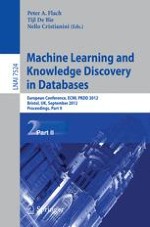This two-volume set LNAI 7523 and LNAI 7524 constitutes the refereed proceedings of the European Conference on Machine Learning and Knowledge Discovery in Databases: ECML PKDD 2012, held in Bristol, UK, in September 2012. The 105 revised research papers presented together with 5 invited talks were carefully reviewed and selected from 443 submissions. The final sections of the proceedings are devoted to Demo and Nectar papers. The Demo track includes 10 papers (from 19 submissions) and the Nectar track includes 4 papers (from 14 submissions). The papers grouped in topical sections on association rules and frequent patterns; Bayesian learning and graphical models; classification; dimensionality reduction, feature selection and extraction; distance-based methods and kernels; ensemble methods; graph and tree mining; large-scale, distributed and parallel mining and learning; multi-relational mining and learning; multi-task learning; natural language processing; online learning and data streams; privacy and security; rankings and recommendations; reinforcement learning and planning; rule mining and subgroup discovery; semi-supervised and transductive learning; sensor data; sequence and string mining; social network mining; spatial and geographical data mining; statistical methods and evaluation; time series and temporal data mining; and transfer learning.
